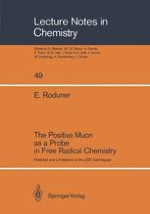1988 | OriginalPaper | Chapter
Experiments employing muons
Author : E. Roduner
Published in: The Positive Muon as a Probe in Free Radical Chemistry
Publisher: Springer Berlin Heidelberg
Included in: Professional Book Archive
Activate our intelligent search to find suitable subject content or patents.
Select sections of text to find matching patents with Artificial Intelligence. powered by
Select sections of text to find additional relevant content using AI-assisted search. powered by
‘Natural’ muons are produced in the following way: light nuclei, mainly protons, from primary cosmic rays fall on the earth with high energy. In collisions with molecules in the upper atmosphere they interact with their nuclei and trigger the production of new particles. One of them, the positive pion, decays with a mean lifetime of 26 ns into a positive muon and a neutrino:(2.1)$$ {\pi ^{ + }} \to {\mu ^{ + }} + {\nu _{\mu }} $$ The pion is a spin-zero particle, but the neutrino has spin $$ \frac{1}{2} $$ with negative helicity, i.e. with its spin pointing in the direction opposite to its momentum in the centre-of-mass system. In order to conserve angular momentum the muon must also have spin $$ \frac{1}{2} $$ and negative helicity.
